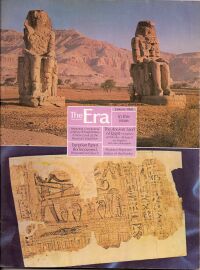The Kirtland Egyptian Papers
Questions
The following critical claims relate to the Kirtland Egyptian Papers (KEP):
- It is asserted that the KEP were produced prior to the Book of Abraham, and that they therefore represent the "translation working papers" for Abraham 1:1-3. A chronology of events related to the production of the Book of Abraham produced by Edward Ashment is used by critics to support this claim;
- It is asserted that the KEP are intended to deal with the Egyptian language, and that they demonstrate that Joseph did not understand Egyptian;
- It is asserted that the KEP demonstrate that the Sensen Papyrus was believed to be the source for the Book of Abraham, and that since the Sensen Papyrus is in fact not the Book of Abraham but an Egyptian Book of Breathings, whatever else the Book of Abraham may be, it is not an accurate translation of an ancient Egyptian text.
- It is asserted that the purpose of the KEP was to provide a visible prop in order to convince people that Joseph could indeed translate Egyptian.
To see citations to the critical sources for these claims, [[../CriticalSources|click here]]
Topics
Summary: Among the early Book-of-Abraham-related-manuscripts that have survived from the days of Joseph Smith are a number of papers collectively referred to as the "Kirtland Egyptian Papers" (KEP). These pages were written while the Saints lived in Kirtland, Ohio, and were recorded in the general time frame that Joseph was translating the Book of Abraham. They are in the same handwriting of several of Joseph's scribes. Critics charge that the KEP represent Joseph's attempt to translate the hieroglyphics from those portions that are still extant, noting that Egyptologists tell us that the alleged "translations" do not accurately reflect the meanings of the hieroglyphics. In some cases, several paragraphs of the English translation of the Book of Abraham are associated with Egyptian characters from the Joseph Smith papyri. In some instances, one Egyptian character seems to yield several sentences of English text. From what may be surmised from the "Kirtland Egyptian Papers" the surviving Egyptian papyri are claimed by critics to be the source for the Book of Abraham. Critics point out that Egyptologists agree that these papyri are part of a collection of Egyptian funerary documents known as the
Book of Breathings and do not deal with Abraham.
- Background and provenance of the Kirtland Egyptian Papers—
Brief Summary: The Kirtland Egyptian Papers (KEP) are a collection of documents written by various individuals, mostly dating to the Kirtland period of Church history (early- to mid-1830s), constituting some sort of study documents relating to the Joseph Smith Egyptian Papyri. (Click here for full article)
∗ ∗ ∗
- Historical LDS approaches to the KEP—
Brief Summary: Critics note at least two evidences which demonstrate an obvious connection between some of the Kirtland Egyptian papers and the Book of Breathings scroll from the Joseph Smith Papyri (JSP). These two evidences are used by critics in an attempt to prove that the existing fragments of the Scroll of Hor is the source of the Book of Abraham and that therefore Joseph was not a prophet. (Click here for full article)
∗ ∗ ∗
- What is the purpose of the KEP?—
Brief Summary: For many years, the KEP were not well studied. A variety of possible explanations have been offered by LDS researchers over the years. One of the more recent approaches postulates that the KEP represent an attempt by Joseph and his associates to create a way to encode revelations and other sensitive data in a form approximating "pure language." Research into this theory is ongoing. (Click here for full article)
∗ ∗ ∗
<videoflash>gfqFGB4DBHQ</videoflash>


